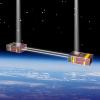news
Turning to CubeSats in the Search for Life Thousands of Light-Years from Earth
Primary tabs
A new NASA-funded project will have Georgia Tech aerospace engineers developing new technology to one day study planets outside our solar system.
It's a $10 million joint mission led by the University of Michigan called STARI — STarlight Acquisition and Reflection toward Interferometry. Georgia Tech’s engineers will build the propulsion systems for a pair of briefcase-sized CubeSats that will fly in orbit a few hundred yards away from one another, bouncing starlight back and forth.
The technology could be used someday to better understand if any known exoplanets are capable of supporting life as we know it.
Interferometry is already used to study stars, gas clouds, and galaxies. Instead of using one large telescope, several smaller telescopes work as a team. The machines swap starlight to create higher resolution images than are possible from a single telescope.
Scientists and engineers have recently proposed using interferometry to locate exoplanets.
STARI will determine if the same type of coordination and light transmission can be done using less expensive CubeSats.
Read the entire story on the College of Engineering website.
Groups
Status
- Workflow status: Published
- Created by: Jason Maderer
- Created: 02/13/2025
- Modified By: Laurie Haigh
- Modified: 02/13/2025
Categories
Keywords

